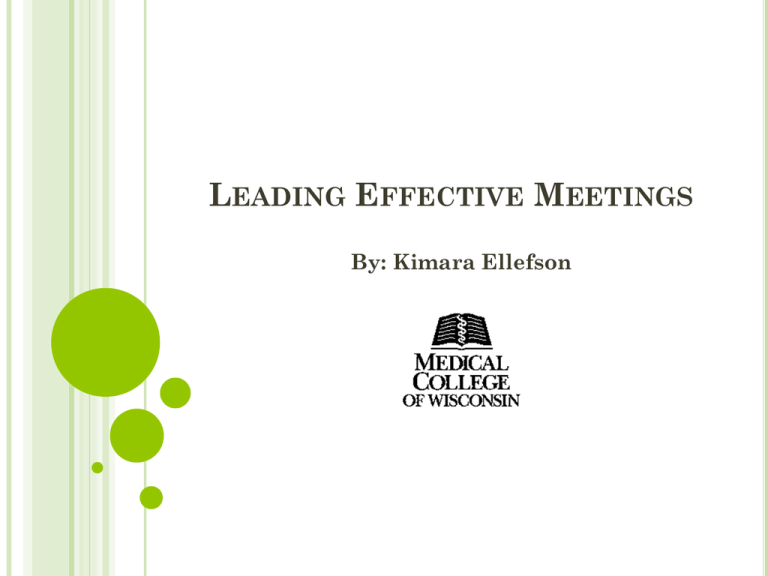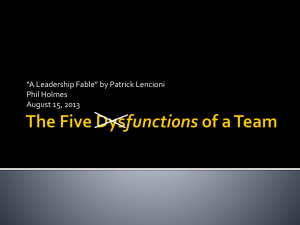Leading Effective Meetings
advertisement

LEADING EFFECTIVE MEETINGS By: Kimara Ellefson Meetings often contain at least one moron that inevitably gets his turn to waste everyone’s time with nonsense. Meetings procreate. One meeting leads to another meeting leads to another… Fried, Jason, and David H. Hansson. "REWORK: The New Business Book from 37signals." 37signals: Web-based Collaboration Apps for Small Business. 37signals, 6 Feb. 2012. Web. 14 Feb. 2012. <http://37signals.com/rework/>. FACT: Research shows that the average individual in our society today will sit through 9,000 hours of meetings in their lifetime! That is over 365 days spent in meetings – not to mention the thousands and sometimes millions of dollars spent on meetings. ABOUT ME 13 Years at MCW Administrative role Spent roughly1,820 hours in meetings over the last year…which means in the 13 years at MCW spent 23,660 hours in meetings So much time in meetings…block off two hours every day just to NOT be in meetings Truly believe in the power of meetings...good and bad. DO YOU DREAD GOING TO MEETINGS? Take a moment to recall your last team meeting: • What does it look and feel like? • How well does your team function? • Who always talks and who never talks? • How does the group make decisions? • Are team members accountable for their contributions to the team? Works Cited: Pigeon, Ed.D, Yvette, and Omar Khan, MD. "Leadership Lesson - Tools for Effective Team Meetings." AAMC. AAMC, 6 Feb. 2012. Web. 13 Feb. 2012. <http://www.aamc.org>. PROBLEM WITH MEETINGS Boring Lack conflict Ineffective/Time Wasting Lack appropriate context or structure Lack of focus Forget what is at stake If there isn’t much at stake, don’t meet! FIVE CONCEPTS FOR LEADING EFFECTIVE MEETINGS 1. Set the stage-Why do I care/What is at stake? 2. Mine for conflict-actively engage all viewpoints 3. Don’t wait for consensus-get all ideas out-then LEAD 4. Drive to Conclusion 5. Everyone supports/takes action/is accountable PLANNING AND PREPARING YOUR MEETING “Perhaps the most important time you will spend in a meeting is the time you spend before the meeting even starts…” SETTING THE STAGE Determine the Purpose To develop your purpose for the meeting ask yourself the following questions: o o o o What is at stake? Why am I holding the meeting? What do I want to achieve at the meeting? What do I want to achieve after the meeting? Tip: Before you begin to move forward with planning your meeting – decide whether or not a meeting is the best way to accomplish your meeting purpose. Prepare a Meeting Plan Determining a meeting type will help simplify your planning process o o o o o Meet to solve a problem Make decisions Gather to share information Hear a presentation Brainstorm ideas THE FOUR MEETINGS Meeting Type Daily Check-in Weekly Tactical Monthly Strategic Quarterly Off-site Review Time Required Purpose and Format Share daily schedules and activities • • • Don’t sit down Keep it administrative Don’t cancel even when some people cannot be there Review weekly activities and metrics, and resolve tactical obstacles and issues • Don’t set agenda until after initial reporting Postpone strategic discussions Discuss, analyze, brainstorm, and decide upon critical issues affecting long-term success • • • Limit to one or two topics Prepare and do research Engage in good conflict Review strategy, industry trends, competitive landscape, key personnel, & team development • • Get out of office Focus on work; limit social activities Don’t over structure or overburden the schedule 5 minutes 45-90 minutes 2-4 hours 1-2 days Keys to Success • • Information from Patrick Lencioni’s Book, Death by Meeting DEFINE: CONTENT & PROCESS PROCESS CONTENT Refers to how the meeting proceeds, how the group works together to accomplish task(s), and to build and maintain cohesiveness Refers to what is talked about at the meeting, the agenda topics, decisions, information, opinions, etc. IDENTIFY MEETING PARTICIPANTS To determine who should attend follow these guidelines: o o o o o Invite those with relevant information or expertise Invite those who will make the final decision Invite people who are affected by or will carry out a decision Consider inviting anyone who might significantly prevent or interfere with the implementation of a decision Invite individuals with higher functional responsibility Tip: Invite as few people as possible while still being inclusive. This varies based on the purpose and intent of the meeting. IDENTIFY GROUP ROLES Leader Timekeeper Keeps written record of proceedings Chart Person Keeps time and lets participants know when it is time to move to the next agenda item Note Taker Responsible for managing the meeting Writes important points of discussion and lists of ideas. Navigator Keep group on track PREPARE THE AGENDA o Agenda: Very simply “Things to be done” o Sequence: Arrange your agenda with the most important items first and least important last in case time runs out o Timing: Assign realistic times to each item, this will determine how long the meeting will last and will enable you to figure out if you have too much on the agenda EFFECTIVE AGENDAS INCLUDE: o o o o o Meeting Purpose-What is at stake? Meeting Logistics (Date, Time, Roles, Participants) Agenda Items Times Assignments (Report out, etc. ) “Every minute you avoid spending in a meeting is a minute you can get real work done instead” Communicating to Participants Includes: o o o o o What is at stake? Who? When? Where? Logistics Meeting Agenda Any special instructions regarding participant preparation Tip: Leaders should not be the only person coming to the meeting prepared. Therefore, providing information ahead of time will increase the chances of better productivity during your meeting. SUMMARY: SETTING THE STAGE Create a statement of Purpose/Outcomes Ask yourself “What do I want the purpose of this meeting to be and what are the potential outcomes? Prepare a Meeting Plan Determine Meeting Type Define Content & Process Identify Meeting Participants/Group Roles Determine Meeting Logistics Prepare the Agenda Communicate with Participants All these should take place before meeting starts! CONDUCTING MEETINGS LEAD, LEAD, LEAD When you lead a meeting, you are a leader and all leadership principles apply: Provide structure Encourage participation Be decisive Hold participants accountable Start Fast o o Starting on Time – Communicate the seriousness of starting on time. Wasting people’s time equals less time working on other projects Stay Focused – Do not allow for other work to be done Tip: Arrange the meeting room that supports dialogue and better communication. Request that cell phones, laptops, iPads not be used during the meetings, i.e. for checking emails FIRST MEETING: UTILIZE INTRODUCTORY ACTIVITIES Set aside 5-15 minutes for introductory items to help get the meeting started. Welcome & Introductions Meeting Purpose Process Ground Rules Meeting Agenda “Parking Lot” MINE FOR CONFLICT Goals: o o o o Keep the Meeting Focused Encourage Full Participation Attend to the Pace Handle Counterproductive Behavior It’s your job to encourage everyone’s full participation WAYS TO MINE FOR CONFLICT Directly Solicit Input from Everyone Ask Open-ended Questions Actively Listen to Others, Be Attentive to Body Language Reinforce and Acknowledge Positive Participation Ask for Concrete Examples Be Supportive Tip: Always maintain control. Don’t forget you are the Leader. Don’t allow another participant to take that role from you. HANDLE COUNTERPRODUCTIVE BEHAVIORS Six Behaviors That May Cause Problems: Overly Talkative Definitely Wrong Highly Argumentative Obstinate Side Conversations Won’t Talk TIPS ON HOW TO HANDLE Overly Talkative Definitely Wrong When they pause for a breath take that time to thank them for input, refocus attention on subject, and move on. Never embarrass the individual. Say you may not have heard them correctly and ask them to rephrase the comment. Highly Argumentative Stay calm! Try to find merit in point and then move on. May also seek group’s opinion. If necessary ask to speak privately. Side Conversation Casually walk to and stand beside the side conversation. Ask one of the parties an easy question or restate your last point and ask for their opinion. Pause and wait for them to notice. Obstinate Throw out issues/ideas for open group discussion. Ask group if they “agree or disagree”. Won’t Talk Bored: around interest by asking their opinion Uninvolved: Engage person seated next to them, then gradually shift focus to draw them in Shy or Insecure: Support with sincere compliment after first time opening up DRIVE TO CONCLUSION Often we walk away from a meeting feeling that nothing is accomplished. Follow these steps below to help create closure to the meeting: o o o Summarize what has been accomplished Compare the accomplishments with the desired outcomes Identify unfinished agenda items and determine ways to address them GET BUY-IN AND ACCOUNTABILITY Complete an action plan – who will do what and when? Summarize Action Items Delegate follow up responsibilities DISTRIBUTING MINUTES Minutes should be handed out to everyone attending the meeting Give direction to participants to review the minutes and action items If these are ongoing meetings, the minutes become the start of the next agenda SUMMARY Remember to: Be a LEADer Start Fast Mine for Conflict Drive to Conclusion Hold everyone accountable EFFECTIVE MEETINGS PRODUCE RESULTS “The clock represents our commitments, appointments, schedules, goals and activities – what we do with and how we manage our time. The compass represents our vision, values, principles, mission, conscience, direction – what we feel is important and how we lead our lives. The struggle comes when we sense a gap between the clock and the compass – when what we do doesn’t contribute to what is most important in our lives.” – Stephen Covey MEETING RESOURCES Best-selling author Patrick Lencioni provides readers with another powerful and thoughtprovoking book, this one centered around a cure for the most painful yet underestimated problem of modern business: bad meetings. And what he suggests is both simple and revolutionary. Information and research gathered for this presentation was from Patrick Lencioni’s book, “Death by Meeting”











